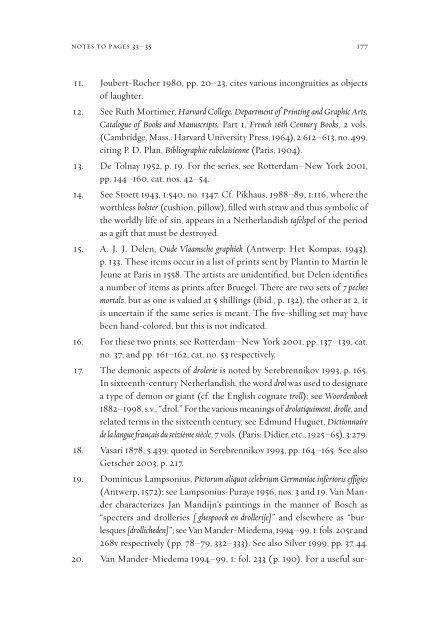Pieter Bruegel and the Art of Laughter - AAAARG.ORG
Pieter Bruegel and the Art of Laughter - AAAARG.ORG
Pieter Bruegel and the Art of Laughter - AAAARG.ORG
Create successful ePaper yourself
Turn your PDF publications into a flip-book with our unique Google optimized e-Paper software.
notes to pages 33–35 177<br />
11. Joubert-Rocher 1980, pp. 20–23, cites various incongruities as objects<br />
<strong>of</strong> laughter.<br />
12. See Ruth Mortimer, Harvard College, Department <strong>of</strong> Printing <strong>and</strong> Graphic <strong>Art</strong>s,<br />
Catalogue <strong>of</strong> Books <strong>and</strong> Manuscripts, Part 1, French 16th Century Books, 2 vols.<br />
(Cambridge, Mass.: Harvard University Press, 1964), 2:612–613, no. 499,<br />
citing P. D. Plan, Bibliographie rabelaisienne (Paris, 1904).<br />
13. De Tolnay 1952, p. 19. For <strong>the</strong> series, see Rotterdam–New York 2001,<br />
pp. 144–160, cat. nos. 42–54.<br />
14. See Stoett 1943, 1:540, no. 1347. Cf. Pikhaus, 1988–89, 1:116, where <strong>the</strong><br />
worthless bolster (cushion, pillow), filled with straw <strong>and</strong> thus symbolic <strong>of</strong><br />
<strong>the</strong> worldly life <strong>of</strong> sin, appears in a Ne<strong>the</strong>rl<strong>and</strong>ish tafelspel <strong>of</strong> <strong>the</strong> period<br />
as a gift that must be destroyed.<br />
15. A. J. J. Delen, Oude Vlaamsche graphiek (Antwerp: Het Kompas, 1943),<br />
p. 133. These items occur in a list <strong>of</strong> prints sent by Plantin to Martin le<br />
Jeune at Paris in 1558. The artists are unidentified, but Delen identifies<br />
a number <strong>of</strong> items as prints after <strong>Bruegel</strong>. There are two sets <strong>of</strong> 7 peches<br />
mortalz, but as one is valued at 5 shillings (ibid., p. 132), <strong>the</strong> o<strong>the</strong>r at 2, it<br />
is uncertain if <strong>the</strong> same series is meant. The five-shilling set may have<br />
been h<strong>and</strong>-colored, but this is not indicated.<br />
16. For <strong>the</strong>se two prints, see Rotterdam–New York 2001, pp. 137–139, cat.<br />
no. 37; <strong>and</strong> pp. 161–162, cat. no. 53 respectively.<br />
17. The demonic aspects <strong>of</strong> drolerie is noted by Serebrennikov 1993, p. 165.<br />
In sixteenth-century Ne<strong>the</strong>rl<strong>and</strong>ish, <strong>the</strong> word drol was used to designate<br />
a type <strong>of</strong> demon or giant (cf. <strong>the</strong> English cognate troll); see Woordenboek<br />
1882–1998, s.v., “drol.” For <strong>the</strong> various meanings <strong>of</strong> drolatiquiment, drolle, <strong>and</strong><br />
related terms in <strong>the</strong> sixteenth century, see Edmund Huguet, Dictionnaire<br />
de la langue français du seizième siècle, 7 vols. (Paris: Didier, etc., 1925–65), 3:279.<br />
18. Vasari 1878, 5:439; quoted in Serebrennikov 1993, pp. 164–165. See also<br />
Getscher 2003, p. 217.<br />
19. Dominicus Lampsonius, Pictorum aliquot celebrium Germaniae inferioris e‹gies<br />
(Antwerp, 1572); see Lampsonius-Puraye 1956, nos. 3 <strong>and</strong> 19. Van M<strong>and</strong>er<br />
characterizes Jan M<strong>and</strong>ijn’s paintings in <strong>the</strong> manner <strong>of</strong> Bosch as<br />
“specters <strong>and</strong> drolleries [ ghespoock en drollerije]” <strong>and</strong> elsewhere as “burlesques<br />
[drollicheden]”; see Van M<strong>and</strong>er-Miedema, 1994–99, 1: fols. 205r <strong>and</strong><br />
268v respectively ( pp. 78–79, 332–333). See also Silver 1999, pp. 37, 44.<br />
20. Van M<strong>and</strong>er-Miedema 1994–99, 1: fol. 233 ( p. 190). For a useful sur












